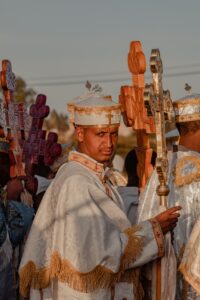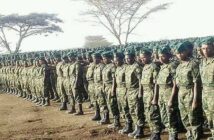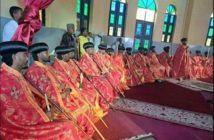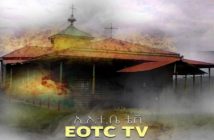Source: Public Orthodoxy
Rev. Calum Samuelson, Doctoral Candidate at the Institute for Orthodox Christian Studies (Cambridge, UK)
Ralph Lee, Oxford Centre for Mission Studies
For the last three years, many have seen headlines about the tragic conflicts that have befallen the nation of Ethiopia. Probably fewer have taken the time critically to read about these conflicts (which have been covered well here and here on Public Orthodoxy). Unfortunately, it seems to us that only a very small number of outside observers have benefitted from increased appreciation of the ancient and beautiful Christian tradition that has long flourished in Ethiopia.
Due largely to geographic and linguistic factors, the wisdom and theology that is stewarded within the Ethiopian Orthodox Täwaḥǝdo Church (EOTC)[1] has mostly been inaccessible to outsiders. This reality has slowly begun to change in recent decades, which means that misunderstandings can and should be remedied. As a general rule in this process, a trusted friend and colleague is fond of reminding us to assess other Christian traditions by the best of their theology, not the worst of their laity. If we can play a small part in encouraging others by highlighting the faithful witness of our brothers and sisters in the EOTC (who don’t sing their own praises!), we will be grateful.
On the Surface
When people discover that we study the sacred literature of the EOTC, a litany of predictable follow-up questions is usually forthcoming. These questions are important because they reflect the general perception of the EOTC globally.
“Do they really possess the Ark of the Covenant?”
Obviously, this question matters on historical and archaeological grounds, but in a very real sense, it is rather the wrong sort of question for fellow Christians to ask. If one seeks sincerely to understand and learn from the ancient Christian witness of Ethiopia, one must accept the fact that the EOTC operates from a firm conviction that the Ark has been entrusted to Ethiopia and that they must steward it in a way that honors God. Ethiopicists have debated the importance and influence of the Ark for decades, but more recently Yirga Woldeyes has emphasized and explicated the concept of covenant drawn from Ark theology—especially that conveyed in the national epic Kəbrä Nägäśt (“The Glory of Kings”)—as a preeminent feature of EOTC theology today.[2] The concept of divine covenant shapes the liturgical activity of every church and the self-perceived vocation of every Orthodox Christian in Ethiopia.
This question about the Ark is closely related to questions about the Solomonic Dynasty as well as others connected to historical validity (e.g. the Ethiopian Eunuch). Rather than perpetuating these unfruitful questions, it may be beneficial for Christians to flip their perspective: “How would my faith tradition operate if we believed that God had selected and empowered us to steward such an awesome symbol of His divine presence on Earth?”
God’s faithful throughout history have not required undeniable scientific proof of Thecla’s deeds nor of the “ethnicity” of Moses the Black in order to be blessed and encouraged by their lives. How might Christians today be inspired by the undeniable faithful witness and vitality of the EOTC?
“Aren’t they just a part of the Coptic Church?”
From an administrative and political perspective, it is true that the EOTC occupied a place under the Patriarch of Alexandria until 1959, meaning that its Metropolitan Bishops were appointed from there. It is also true that there are significant similarities in terms of theology and liturgy. However, merely to group the EOTC along with the Coptic tradition neglects the vast amount of unique literature, hagiography, history, theology, iconography, music, and more that is unique to Ethiopia and Eritrea. Furthermore, although increasing theological approximations are often used to demonstrate affinity within the Oriental family of Orthodox churches, it is vital to note that the EOTC avoids the use of the term ‘miaphysite’ in preference for the mysterious and non-technical implications of the term täwaḥǝdo.
“Does Ethiopia possess the oldest Bible?”
Thanks to images and sound bites circulating across the internet, some have imbibed incomplete views about the Ethiopic Scriptures. It is true that the Gärima Gospels (two manuscripts of which have been carbon dated to the 6th century[3]) may be the oldest extant illuminated Gospel codex in the world (it is not, therefore, the oldest Bible nor even the oldest surviving Gospel book). Far more important is the fact that Gǝʿǝz was one of the very first languages into which the Christian Scriptures were translated, which probably occurred by the early 5th century. This has fostered an inestimable amount of original theological reflection in Ethiopic languages, including the extensive and vastly understudied traditional Amharic biblical commentaries (ʾAndǝmta).
Related to the question about the antiquity of the Ethiopic Scriptures are questions about the “canon”,[4] which famously includes the books of 1 Enoch and Jubilees. Much could be said here about the influence of such texts upon the EOTC’s eschatology, metaphysics, and demonology[5] (among other things), but Orthodox Christians especially should be reminded of how precious Christian texts can be (and have been) held in high regard without necessarily featuring explicitly in liturgical services.
Within the Fold
Beyond rectifying misunderstandings about the EOTC, we believe that other Christian traditions can benefit greatly by engaging with this beautiful branch of Christ’s Church. Here are three general areas ripe with potential:
Embodied, Organic, non-Western Theology
Because the EOTC was largely independent from other Christian traditions for roughly 1,500 years, it exhibits important approaches and perspectives that are quite different from the abstract, systematic, and propositional thinking many are accustomed to in Western Christian literature and tradition.” Sometimes correlated with “Semitic” or “Syriac” thought, the theology of the EOTC offers powerful insights about topics such as the environment, the role of women, and spiritual formation. Crucially, this is not to say that such insights are divergent from the broader Christian faith. Instead, central convictions, such as the “doctrine” of theōsis, are explored, advocated, and defended through indigenous vocabulary, metaphors, and anecdotes. We believe that Western Christians of all kinds can be sharpened like iron simply through interacting with the theology and fellowshipping with the adherents of the EOTC.
Ancient and Unique Liturgical and Intellectual Heritage
The liturgical texts, music, and trappings of the EOTC are some of the oldest in the world. Originating with St Yared in the 5th century, they contain perspectives, melodies, and symbolism found nowhere else. Although still largely impenetrable to outsiders, it can be deeply edifying to observe and consider how ancient Ethiopian Christians have tirelessly channeled the sum of their energy, resources, and culture in order to worship God in Spirit and Truth.
The intellectual heritage of Ethiopia is also laudable and challenging. Giyorgis of Sägla authored a formidable exploration of Christian doctrine (Mäṣhafä Mesṭir) hundreds of years before Descartes and Locke and with zero apparent influence from thinkers such as Aquinas or Palamas. Other original Ethiopian works, such as the Hatata,[6] demonstrate the vigor and acumen of EOTC Christians who were driven by their all-encompassing convictions about the Christian life.
Vibrant and Living Spiritual Tradition
Ethiopia boasts significantly more practicing Christian monks than any other country.[7] These monks steward the faith of the EOTC not simply by copying manuscripts, but also through dynamic methods of learning that have been described as the “one of the oldest continuous systems of learning in the world”.[8] The illustrious Qine Bet, for instance, weaves together a deep, personal knowledge of Scriptural and Patristic texts in elaborate extemporaneous compositions that simultaneously join ancient wisdom with current realities of daily life.
Although the priceless wisdom and witness of the ETOC are only just becoming accessible for Christians outside the tradition, it does not seem like a coincidence that this is occurring as Christianity in Western nations struggles in unprecedented ways with its own vocation and faithfulness to Christ.
We would like to thank our Ethiopian colleague, Dr. Daniel Assefa, for his keen and helpful suggestions about how best to articulate the unique Christian tradition of Ethiopia.
[1] The Ethiopian Orthodox Täwaḥǝdo Church and the Eritrean Orthodox Täwaḥǝdo Church were joined within the same tradition until 1993. Except for a brief period of disagreement, they maintain full communion. We use the standard acronym “EOTC” here for simplicity and do not suggest any exclusion of the important Eritrean Church.
[2] Yirga Gelaw Woldeyes, Native Colonialism: Education and the Economy of Violence Against Traditions in Ethiopia (Trenton, NJ: Red Sea Press, Inc., 2017).
[3] J. McKenzie and Francis Watson, The Garima Gospels: Early Illuminated Gospel Books from Ethiopia (Oxford: Manar Al-Athar, University of Oxford, 2016), 40–41.
[4] Cf. Bruk A. Asale, “The Ethiopian Orthodox Tewahedo Church Canon of the Scriptures: Neither Open nor Closed,” The Bible Translator 67, no. 2 (August 2016): 202–22.
[5] One fascinating example of the demonology of the EOTC is the controversial and somewhat cryptic genre of literature called Asmat Roles (less correctly described as “Magic Scrolls”), which contain detailed prayers of exorcism for a range of different demonic beings and ailments—still in production after roughly 500 years.
[6] See Zara Yaqob and Walda Heywat, The Hatata Inquiries, ed. Lee Ralph, Worku Mehari, and Belcher Wendy Laura (De Gruyter, 2023).
[7] Rough estimates suggest that there are approximately four times as many active monks in Ethiopia (~60,000 [an average of 75 in each of 800 monasteries]) than in Russia (~15,000). Cf. http://www.patriarchia.ru/db/text/5359105.html.
[8] Richard Pankhurst, A Social History of Ethiopia (Addis Ababa, 1990), xi.
ABOUT AUTHORS
Rev. Calum Samuelson
Doctoral Candidate at the Institute for Orthodox Christian Studies (Cambridge, UK)
Reverend Calum Samuelson is an ordained minister in the Free Methodist Church and a Ph.D. candidate at the Institute for Orthodox Christian Studies in Cambridge, England. He has taught theology to hundreds of university students in Chicago and Nairobi. His main area of academic focus is Ethiopian monasticism, and he is involved in several international projects that aim to preserve, catalogue, transcribe, and translate Medieval Ethiopic manuscripts (e.g. The Ethiopic Manuscript Imaging Project [EMIP] and the Beta Maṣāḥǝft [Universität Hamburg]). Calum is a leader in the Lausanne-Orthodox Initiative and also works closely with the Oxford Centre for Mission Studies. In all of these activities, he strives to remedy misunderstandings between different Christian traditions and foster deeper modes of fellowship.
Ralph Lee
Oxford Centre for Mission Studies
Dr. Ralph Lee works at the Oxford Centre for Mission Studies in the UK, where he leads work on the understanding of mission from the perspective of the Orthodox Church. He also is Facilitator for theLausanne-Orthodox Initiative, a global network that encourages good relationships between Orthodox and Evangelical Christians with the aim of removing historical impediments to the mission of God especially in countries where there is a strong Orthodox Christian presence.
His original profession of Chemical Engineering led him to work in Ethiopia, where he was drawn to Ethiopia’s ancient and rich Christian tradition, which ultimately led to a change of profession to the study of Orthodox Christianity. He retrained at the School of Oriental and African Studies University of London, completing a doctorate exploring key themes of Ethiopian Orthodox theology, and subsequently taught at the Holy Trinity Theological College of the Ethiopian Orthodox Tewahedo Church in Addis Ababa. After a total of 16 years living in Ethiopia, he has settled with his family in Cambridge, UK. His current research focus is on Ethiopian Christian thought, and interpretation of the bible, with a particular focus on 1Enoch, part of the Ethiopian Orthodox “canon”. He has a diverse set of doctoral students exploring themes on Orthodox Christianity, especially in Ethiopia.




